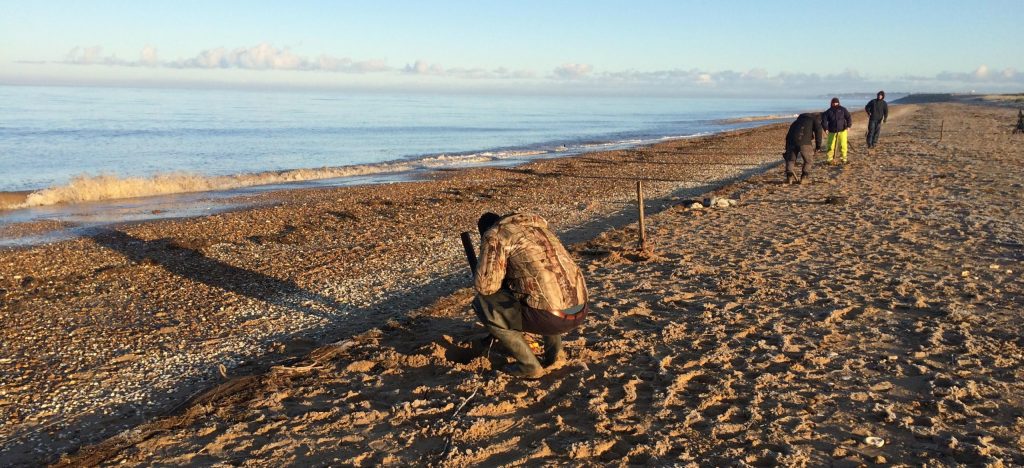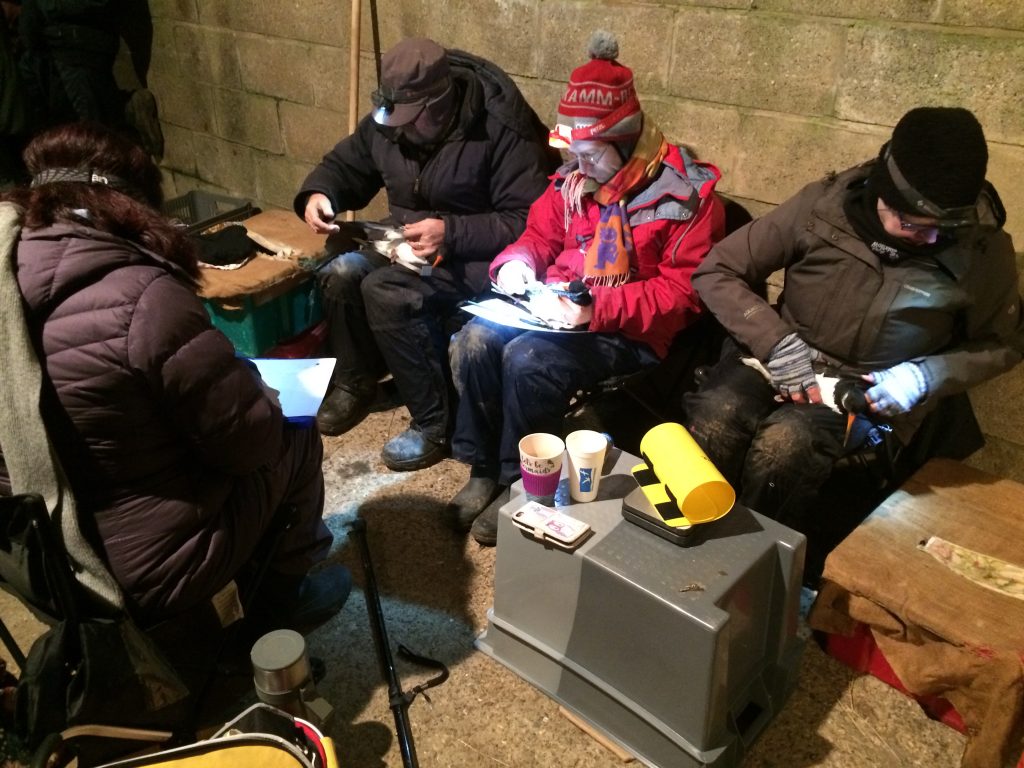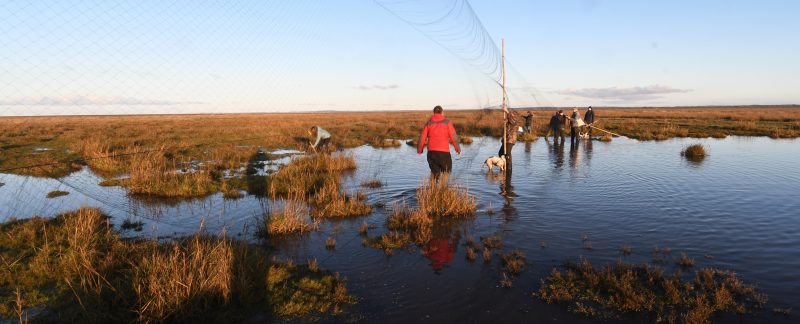Recce and plan for the weekend
The good news for the team was that, for once, the weather gods seemed to be on our side with a forecast of sunshine, low temperatures and little wind. Plans were therefore put in place for a full weekend with a cannon-net catch attempt on Saturday morning, mist netting on Saturday evening and a possible second cannon-net attempt on Sunday.
The first part of any field work weekend is for a recce to be undertaken to determine the options for catching. Lizzie and Ryan kindly offered to do the recces on Snettisham and Heacham beaches, arriving at the fieldwork base on Thursday evening for an early start on Friday morning. Cathy not only made the trip to meet Lizzie and Ryan at the base on Thursday afternoon to deliver the keys but also stayed to cook for them before returning home which was greatly appreciated.
Lizzie and Ryan arrived on Heacham south beach at 07:00 when there was already quite a bit of disturbance from dog walkers and so on. The only substantial flock at Heacham was approximately 200 Curlew. They was not an option for catching however as it is very difficult to make a dry catch on the beach. A group of around 15 Grey Plover was found on Snettisham beach along with several small flocks of Sanderling. The birds remained on the beach despite considerable disturbance. As Grey Plover is one of the target species for the group and one which the group marks with leg flags, this seemed to be a good option, particularly if the beach could be kept free of disturbance and if decoys could be placed in the catching area before first light.
As well as undertaking the recces for the weekend catches, Ryan and Lizzie also made a start to the resighting efforts with several marked Curlew, Bar-tailed Godwit and a single Turnstone seen.
Friday 29 November
There was a highly experienced team at the Wash for this weekend with five cannon-net licensees and three cannon-net trainees. Mark and Lucy took responsibility for organising the weekend, whilst allowing the trainees to do many of the individual tasks associated with the planning and catching attempts.
Lizzie, one of the group’s three cannon-net licence trainees, led the briefing on Friday evening, outlining the plans for the weekend. After enjoying Ron’s lovely meal, the team left the base around 20:45 to set three small-mesh nets on Snettisham Beach. Some late arrivals met us at the beach whilst others went straight to the base. With such a strong team (and good organisation), the nets were set in good time enabling the team to get to bed for a few short hours before the 05:15 alarms. A minor problem arose in that the leave time was put forward by 15 minutes to ensure a timely arrival on the beach but several members of the team had already gone to bed by the time this decision was made. Everyone made the leaving time though it was a bit of a rush for some!

Saturday 30 November
On arrival at the beach, there were no Grey Plover to be seen but there were small flocks of Sanderling. Unfortunately, despite the best efforts of Mark, Guy and Ron to gently twinkle the birds into the catching area, the birds failed to co-operate and left the beach so no catch was made. Once a catch seemed unlikely, two groups of people went with telescopes to look for colour-marked birds, one group to Heacham and one to Snettisham. It was a lovely morning to be out and both groups enjoyed themselves, and gathered some useful data, whilst the rest of the team lifted the nets and returned to base.
Nigel and Jacquie arrived on Saturday morning and went to Heacham and Hunstanton beaches to look for Turnstone with a view to the possibility of catching a small number of these on Sunday morning. There were around fifty Turnstone on Hunstanton beach and a smaller number on Heacham NN but not a single one with colour rings (although Jen received a sighting form a member of the public of a colour-ringed Turnstone on Hunstanton Beach on Saturday which must have been hiding from Jacquie and Nigel!).
For once, the weather was perfect for mist netting and, after a good breakfast, most of the team left for Terrington Marsh at 14:00 to set two groups of nets, one of six nets and the second of twelve. Jen and Mark stayed behind on the marsh to watch the nets whilst the rest of the team headed back to base for tea. Nigel was hopeful that a catch of between 50 and 100 birds could be made during the evening.
With high tide at 20:39, the sound lures were set by 18:30. The plan at the White Barn nets was for 15-minute net rounds. This plan soon fell apart due to a constant influx of birds into the nets which kept the team busy on a continuous net round for most of the session. The first bird in the net was a Wigeon! The large birds were taken back to base to be ringed and processed straight away as usual whilst the smaller birds were placed into keeping cages.

A very pleasant evening was spent ringing and processing the catch which, at 163 birds, far exceeded Nigel’s expectations. This was an unusually high Dunlin catch, with 130 out of the total of 163. The eight Grey Plover, which were all given leg flags, was also a good result for the team (particularly as we had failed to catch any this morning). Also pleasing was the opportunity that two long-term group members had to ring new species – Dave ringed the Wigeon and Ron ringed the Snipe.
The birds were all safely released and the team packed away and were all back at base before midnight ready for another early start on Sunday morning.
Catch totals
| Species | New | Retrap | Total |
| Dunlin | 126 | 4 | 130 |
| Grey Plover | 8 | 0 | 8 |
| Oystercatcher | 7 | 1 | 8 |
| Redshank | 5 | 2 | 7 |
| Knot | 4 | 0 | 4 |
| Curlew | 2 | 0 | 2 |
| Bar-tailed Godwit | 2 | 0 | 2 |
| Snipe | 1 | 0 | 1 |
| Wigeon | 1 | 0 | 1 |
| Total | 156 | 7 | 163 |
Sunday 1 December
The options for Sunday morning were for a catch attempt on Heacham NN beach for Turnstone and/or resighting of colour-marked birds. Given that the resighting effort of the team was ahead of schedule for the time of year, most of the team chose to go for the cannon-net attempt. Two small-mesh nets were set on the beach ahead of high tide in an attempt to catch Turnstone and, possibly, Ringed Plover. This provided an opportunity for the team to set nets in the light and to watch the firing. Unfortunately, there were only a small number of Turnstone on the beach but three birds were caught, one of which was already ringed and colour-marked. The two un-ringed Turnstone were given metal rings and a combination of colour rings.
Catch totals:
| Species | New | Re-trap | Adult | Juvenile | Total |
| Turnstone | 2 | 1 | 2 | 1 | 3 |
Following the catch on Sunday morning, the team made a short video to send to Australia for the memorial service for Clive Minton. Rob introduced the current cannon-net licensees, including Phil who took over as group leader from Clive, Mark and Lucy who were trained by Phil and who have subsequently trained others and the three new trainees. Lizzie talked about her own experiences in the group as a cannon-net trainee and her memories of meeting Clive in August 2018.
Other members of the team spent the morning looking for colour-marked birds. Nigel and Jacquie made a trip to Freiston to look at possible catching options for the future and contributed to the team’s resighting efforts with several Black-tailed Godwits whilst a small number of people stayed out to catch the falling tide at Heacham NN, Heacham North and Heacham South beaches.
Re-sighting totals for the weekend
| Species | Sightings | Individuals | WWRG | Non-WWRG |
| Curlew | 21 | 20 | 19 | 1 |
| Bar-tailed Godwit | 44 | 30 | 30 | 0 |
| Turnstone | 33 | 15 | 15 | 0 |
| Oystercatcher | 1 | 1 | 0 | 1 |
| Redshank | 1 | 1 | 0 | 1 |
| Black-tailed Godwit | 12 | 11 | 0 | 11 |
| Total | 112 | 78 | 64 | 14 |
Thanks to everyone for all their help in the various tasks, particularly the cooks and washer-uppers.
Congratulations to Lizzie on taking her first cannon-net catch.

